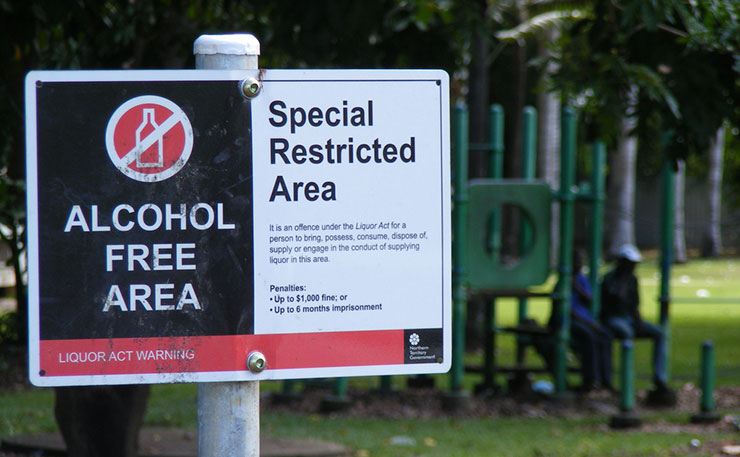In his ongoing series, Michael Brull looks at the effects of the Northern Territory Government’s ‘paperless arrest’ laws.
In my previous two articles, I discussed the High Court’s shameful response to the paperless arrest scheme in the Northern Territory, which empowers police to arrest people because they might in the future commit trivial offences. I argued that the laws the High Court had legitimised would result in deaths in custody.
The laws have already had that effect. That was demonstrated by the Inquest into the death of Kumanjayi Langdon. It was performed by Greg Cavanagh SM, delivered on 14 August this year. In this series, I discuss the death in custody of Kumanjayi Langdon.
Kumanjayi Langdon
Kumanjayi Langdon was a proud Walpiri man. He was one of 10 children, born on 14 September 1955. He worked at a mine, at a school, and as an artist. He was well loved in the community, and had a loving relationship with his wife Nancy Oldfield.
He was also survived by his children, and extended family. His cultural brother, Rex Granites, observed that he was a “happy man, a great storyteller and made everybody laugh. A lot of people miss him.” He led cultural ceremonies, and was involved in men’s sorry camps.
In later years, as he stopped working, he would speak to young people under a tree and share stories, and people would call it “the tree of knowledge”.
Kumanjayi contributed his drawings to children’s books used in schools, and painted key buildings in the community of Yuendumu. One of his paintings is in the collection of the National Gallery of Victoria.
Kumanjayi had a history of serious health issues. The reason he was in Darwin when he died was in pursuit of medical treatment for his heart condition.
On 11 May, he went from Yuendumu to Alice Springs, and from there to Darwin for an appointment, which he happened to miss, for an angiogram at the Royal Darwin Hospital on 14 May.
He was arrested by police on 15 May whilst severely intoxicated, and then transferred to the hospital for five hours.
On 19 May, he was taken by police to the hospital again, as he was severely intoxicated and was suspected of suffering a fall. He was released from hospital on 20 May, the day before he died.
As was clear, Kumanjayi had serious health issues. His clinical notes recorded:
2004: cardiomyopathy. 2010: diabetes. October 2014: pulmonary oedema. February 2015: congestive cardiac failure and congestive cardiomyopathy. April 2015: cardiomegaly (enlarged heart). On 31 March, an echo test showed “severe pulmonary hypertension and dilated cardiomyopathy.”
Cardiologist Ian Agahari saw Kumanjayi, and wrote in a letter on 6 April 2015 about Kumanjayi’s health issues. In the words of Cavanagh, the letter showed “significant health issues related to Kumanjayi’s heart – in short, that Kumanjayi was showing the symptoms and signs of heart failure… Dr Agahari wrote: “Overall, I think this gentlemen [sic]needs a lot of work and there should be a low threshold in admitting this gentleman’.”
Kumanjayi was again treated on 21 April and 12 May for congestive cardiac failure. In short, Kumanjayi turned up at Darwin a very sick man, in urgent need of serious medical care.
Within 10 days of leaving Yuendumu to take care of his heart condition, he was dead.
A dubious arrest
Police allegedly saw Kumanjayi drinking alcohol from a green plastic bottle on 21 May, in Darwin’s CBD, near Spillett House. Police claimed that he appeared intoxicated, and tried to conceal the bottle.
Senior Constable Michael Deutrom arrested him for drinking in a public place. He was then joined by two more police officers, who found Kumanjayi sitting on a bench, handcuffed.
They found alcohol in the park, which they tipped out.
The three police never found the alleged green plastic bottle that Kumanjayi was supposedly seen drinking, and it was not with him at the time of the arrest.
Cavanagh writes that Kumanjayi was “not violent, was not uttering threats and not swearing or being offensive in any way. He continued to be quiet and cooperative at all times during his dealings with police officers.”
Counsel for Kumanjayi’s family wanted Cavanagh to conclude that the arrest was unlawful, as there was no real evidence that he had been drinking in public. Cavanagh rejected this, on the grounds that “there was some indicia of drinking in a public place” (but, contra Cavanagh, no indicia that this drinking had been done by Kumanjayi). He also offered this additional – somewhat dismaying – ground for the lawfulness of the arrest: “Spillett Park was known to be somewhere Aboriginal people like to drink”.
Cavanagh went on to suggest that the arrest may have been “disproportionate” and “unreasonable”, as less serious sanctions than arrest were also available to the officers.
Whilst this is true, the “indicia of drinking in a public place” that Cavanagh cites consists entirely of evidence that other Aboriginal people drank in the area at some point. By this reasoning, Cavanagh seems to suggest that simply being Aboriginal is sufficient cause for police to lawfully arrest people in the area.
Whilst Cavanagh does make criticisms of systemic failures, and the discriminatory operation of the law, it is worth noting his general deference to the police. The arresting officer is “sincere and conscientious”. The Custody Sergeant at the Darwin Watch House was Sergeant Paul Jones. Cavanagh had “no doubt” that he, “like each of the officers who gave evidence before me, is a responsible and caring police officer, who takes his custody duties extremely seriously.”
The benefit of this approach is that the focus of his analysis is systemic issues, rather than focussing excessively on this or that individual. Yet the price is exonerating behaviour that I would suggest warrants greater critical scrutiny.
For example: Kumanjayi was almost 60 years old, with serious heart issues, and quite drunk, with an alcohol level of 0.270%. He cooperated with police at every stage, yet there was no evidence of the green bottle he was supposedly drinking from. Cavanagh never expresses any scepticism about how Kumanjayi managed to slip the alcohol he was supposedly drinking publicly past the three police officers who handled his arrest.
As will be seen, Cavanagh does raise questions about police policy of arrests.
A failed health check and a death in custody
Kumanjayi arrived in the Watch House at 6:37 pm. By 9:07, he had been dead for a while. As we have seen, he had serious health issues, which had alarmed the cardiologist he had seen a month earlier.
The police intake procedure involved a three-staged health assessment. These include a questionnaire, basic health tests by the custody nurse, and then an overview of the process signed by the Custody Sergeant. The third stage was not completed, though it is not clear what kind of effect this third step would have had.
The three-stage approach was implemented as a result of Cavanagh’s suggestions in his inquest into the death in custody of Kwementyaye Briscoe. Cavanagh expresses appreciation of the “momentous improvement” in police procedures he observed since that case.
When Sergeant Paul Morrissey arrived at the Watch House, he immediately went to the reception desk and told Custody Nurse Fiona McColl that Kumanjayi had been taken to hospital the previous week, and she should check his medical records.
As we have seen, police took him to hospital on 15 May and 19 May. As we have seen, the cardiologist who saw him said “there should be a low threshold in admitting this gentleman”. Nurse McColl claims to have looked up his records, and says she only focused on his possible seizure a few days earlier.
Sergeant Morrissey completed the health questionnaire with Kumanjayi, and Cavanagh says CCTV footage shows he was “professional and courteous.” He asked if Kumanjayi had a health condition. Kumanjayi replied: “sometimes… heart problem”. He said he took medication for it, and denied having other issues. Kumanjayi said he’d had around four beers that day.
Nurse McColl took the health check from 6:34 to 6:39 pm. Cavanagh wrote that Kumanjayi arrived in the watch house at 6:37, but this may be explained as a typographical error. Kumanjayi may have actually arrived at 6:27. CCTV shows that Kumanjayi repeatedly asked to see a doctor. As in “where’s my doctor”, “doctor”, “I need to go to a doctor”, and “doctor I want her to come”.
Cavanagh observed that “It is evidence that neither Nurse McColl nor Police took seriously Kumanjayi’s request to see a doctor… For Nurse McColl, who did not have a complete understanding of Kumanjayi’s serious health problems, she did not consider that he needed a doctor.”
Cavanagh writes that if she had “completed a more thorough check of the e-health records that she had access to, it would have been immediately obvious that Kumanjayi suffered from a chronic and severe health condition for which he had been recently hospitalised.”
It was her job to do so. She was asked by the police Sergeant to do so. She failed to do so, and within a few hours, he died in a cell.
Cavanagh still exonerates her, saying that her assessment, “whilst not thorough, was adequate, and was what might be expected in the context of a very demanding shift.” “Ideally”, he says, she would have actually “taken more time” to review his health records, but “it is self-evident that the more prisoners police and nurses have to deal with, the less time they have to do a detailed history check. Nurse McColl was doing her best in challenging circumstances.”
The Custody Sergeant, also particularly busy, failed to fill out the Custody Health Assessment. Kumanjayi was then taken to Cell 5, where he lay down to sleep.
Police didn’t realise he was dead until 9:07pm. He was not marked as an “at risk” prisoner, and so police roughly conducted checks every 15 minutes for half an hour, then every half an hour. Cavanagh says that the Police conducted these checks, and there is “no doubt that Police across the shift took their obligations to check on prisoners seriously.”
Cavanagh reasonably observes that it is difficult to check on sleeping prisoners, and it would be “unreasonable” to wake them for these checks. The checks were conducted through Perspex, and so the police failed to realise that Kumanjayi was not breathing. The police then tried to help, to no avail.
It is not clear if Kumanjayi’s death could have been avoided, or what difference would have been made by a different standard of care. However, Cavanagh does argue, with some justice, that the reason Kumanjayi died in custody was because of the Northern Territory Government, senior police command, and the paperless arrest scheme. This will be explored in the second part of my analysis of this case.
ED’S NOTE: Part II will be published tomorrow, December 15, 2015.
Donate To New Matilda
New Matilda is a small, independent media outlet. We survive through reader contributions, and never losing a lawsuit. If you got something from this article, giving something back helps us to continue speaking truth to power. Every little bit counts.





